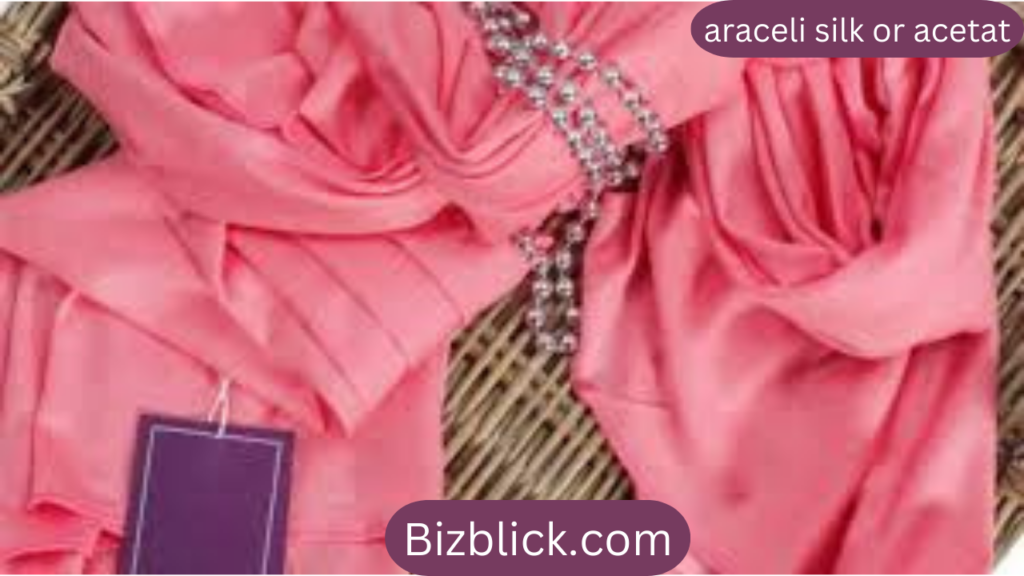When it comes to luxurious fabrics, silk and acetate are two materials that frequently capture attention. They are often compared for their beauty, texture, and versatility. “Araceli Silk or Acetat” is a subject that delves into the characteristics, differences, and practical uses of these fabrics. This guide provides a detailed exploration of both materials to help you make an informed choice based on your needs.
What Is Araceli Silk?
The Origins of Silk
Silk is one of the oldest and most prized natural fibers in the world. Originating in ancient China, silk production (sericulture) involves harvesting the fibers from the cocoons of the silkworm. Over centuries, silk became synonymous with luxury and elegance.
Characteristics of Araceli Silk
Araceli Silk is a premium-grade silk known for its:
- Soft Texture: Exceptionally smooth to the touch.
- Natural Sheen: A lustrous finish that enhances its beauty.
- Durability: Despite its delicate appearance, silk is surprisingly strong.
- Breathability: Keeps you cool in summer and warm in winter.
Common Uses of Araceli Silk
- Apparel: Evening gowns, blouses, and scarves.
- Home Décor: Curtains, pillowcases, and upholstery.
- Accessories: Luxury handbags and ties.
Understanding Acetat
What Is Acetate?
Acetate is a synthetic fiber derived from cellulose, the primary component of plant cells. It was first developed in the early 20th century as a cost-effective alternative to silk.
Key Features of Acetate
- Silk-Like Feel: Mimics the softness of silk.
- Glossy Appearance: Often has a satiny sheen.
- Lightweight and Drapable: Perfect for flowing garments.
- Color Retention: Holds dye well, resulting in vibrant colors.
Popular Applications of Acetate
- Clothing: Lining for suits, jackets, and dresses.
- Home Essentials: Bed linens and drapes.
- Industrial Use: Packaging materials and film production.
Comparing Araceli Silk and Acetat
Composition and Origin
- Araceli Silk: Natural fiber produced by silkworms.
- Acetate: Semi-synthetic fiber made from cellulose.
Texture and Appearance
- Silk: Luxurious, smooth, and natural luster.
- Acetate: Soft, shiny, but less natural in sheen.
Durability and Maintenance
- Silk: Requires delicate care; dry cleaning is often recommended.
- Acetate: More durable but sensitive to high heat and solvents.
Cost and Availability
- Silk: Expensive due to its natural production process.
- Acetate: Affordable and widely available.
Benefits of Araceli Silk
- Hypoallergenic: Ideal for sensitive skin.
- Eco-Friendly: Biodegradable and sustainable when ethically produced.
- Timeless Appeal: Silk never goes out of style.
- Moisture Absorption: Keeps you dry by wicking away sweat.
Advantages of Acetate
- Affordability: Offers luxury at a lower cost.
- Versatility: Suited for various applications beyond clothing.
- Ease of Use: Wrinkle-resistant and easy to maintain.
- Vibrancy: Retains rich colors over time.
Disadvantages of Araceli Silk
- Cost: Premium quality comes at a high price.
- Delicate Nature: Prone to snags and stains.
- Care Requirements: Requires professional cleaning for longevity.
Drawbacks of Acetate
- Heat Sensitivity: Can melt or deform under high temperatures.
- Environmental Concerns: Production involves chemical processes.
- Less Durable: May not withstand heavy wear and tear.
Choosing Between Araceli Silk and Acetat
Factors to Consider
- Budget: Silk is for those who prioritize luxury, while acetate is budget-friendly.
- Usage: For high-end garments or home décor, silk is ideal. For everyday wear, acetate suffices.
- Sustainability: Silk is more environmentally friendly when sourced ethically.
Personal Preference
Ultimately, the choice depends on individual tastes. If you value authenticity and luxury, Araceli Silk is your go-to. If you seek affordability and practicality, acetate fits the bill.
Caring for Araceli Silk
- Washing: Use mild detergents and cold water.
- Drying: Air dry; avoid direct sunlight.
- Storage: Store in a cool, dry place away from pests.
Maintaining Acetate
- Washing: Hand wash or machine wash on a gentle cycle.
- Drying: Avoid high heat; air drying is best.
- Ironing: Use a low heat setting with a protective cloth.
Frequently Asked Questions
Is Araceli Silk worth the investment?
Yes, especially for those who value luxury, comfort, and timeless elegance.
Can acetate replace silk in all applications?
Not entirely. While acetate mimics silk’s texture and appearance, it lacks the natural appeal and durability of silk.
How do I know if a fabric is genuine silk?
Perform a burn test: Silk burns with a slow flame, leaving behind a crisp ash, while acetate tends to melt.
Which fabric is more sustainable?
Silk is more sustainable when produced ethically, as acetate involves chemical manufacturing processes.
Conclusion
Araceli Silk and Acetat each offer unique qualities that cater to different needs. Silk represents luxury, elegance, and natural beauty, while acetate provides affordability, versatility, and modern convenience. Understanding their characteristics, benefits, and applications can help you make the best choice for your lifestyle and preferences.
Whether you’re selecting fabric for clothing, décor, or industrial use, this guide ensures you have all the information needed to make an informed decision.
